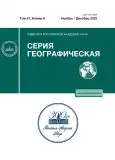Are “Bear Corners” Homogeneous: Differentiation of Regions Along the Vologda–Kostroma Border
- Авторлар: Averkieva K.V.1, Zernov F.V.2
-
Мекемелер:
- Institute of Geography, Russian Academy of Sciences
- HSE University, Faculty of Geography and Geoinformation Technologies
- Шығарылым: Том 87, № 8 (2023)
- Беттер: 1287-1302
- Бөлім: РЕГИОНАЛЬНЫЕ ГЕОГРАФИЧЕСКИЕ ПРОБЛЕМЫ
- URL: https://journals.rcsi.science/2587-5566/article/view/243589
- DOI: https://doi.org/10.31857/S2587556623080046
- EDN: https://elibrary.ru/GORSJM
- ID: 243589
Дәйексөз келтіру
Толық мәтін
Аннотация
The article considers a strip of municipal districts on the border of Kostroma and Vologda oblasts–a territory that simultaneously belongs to the periphery of both regions, the periphery of economic regions and modern federal districts, and the inner periphery of European Russia. The territories under consideration are part of the old-developed non-Chernozem zone, which is characterized by rapid depopulation and shrinkage of the developed space. The purpose of the study is to identify the spatial differentiation of areas along the border and its role in the formation of differences between the territories. Various methods were used: the study of historical maps, the analysis of modern statistics, methods of qualitative sociology, and field observations. The study showed the predominantly barrier function of the regional border, largely due to physical and geographical reasons–the watershed of the Volga and White Sea basins and the configuration of rivers along which local systems historically formed rural settlement pattern and transport corridors. The historical multidirectional spatial gravity of regions on different sides of the border, combined with institutional barriers, led to the differentiation of economic and social processes in municipal regions. Thus, the socioeconomic indicators of the regions on the Vologda side of the border are generally more prosperous and differ less from each other than on the Kostroma side. The study also revealed an extremely important role that interregional routes could play. With a general trend towards a reduction in the rural population and fragmentation of the local economy, the territories on both sides of the border are heterogeneous, and various combinations of place functions are formed. At the same time, it is premature to attribute a strip of peripheral territory in relation to many centers to the zone of a spontaneously formed natural reserve.
Авторлар туралы
K. Averkieva
Institute of Geography, Russian Academy of Sciences
Хат алмасуға жауапты Автор.
Email: k_averkieva@igras.ru
Russia, Moscow
F. Zernov
HSE University, Faculty of Geography and Geoinformation Technologies
Email: k_averkieva@igras.ru
Russia, Moscow
Әдебиет тізімі
- Аверкиева К.В. Внутрисельская миграция населения и локальные процессы трансформации сельской местности в лесной зоне староосвоенного Нечерноземья // Изв. РАН. Сер. геогр. 2021. Т. 85. № 6. С. 828–841. https://doi.org/10.31857/S2587556621060066
- Аверкиева К.В. Постсоветская трансформация лесных поселков на севере Нечерноземья // Крестьяноведение. 2021. Т. 6. № 3. С. 90–110. https://doi.org/10.22394/2500-1809-2021-6-3-90-110
- Баранский Н.Н. Экономическая география СССР: обзор по областям Госплана. М.–Ленинград, 1927. 336 с.
- Вендина О.И., Зиновьев А.С. Пограничность и периферийность: к вопросу о контексте формирования калининградской идентичности // Мир России. 2022. Т. 31. № 2. С. 118–143. https://doi.org/10.17323/1811-038X-2022-31-2-118-143
- Волго-Вятский район. Экономико-географическая характеристика / сост. Г.П. Матвеев, Г.А. Приваловская, Б.С. Хорев. М.: Географгиз, 1961. 535 с.
- Географические границы / под ред. Б.Б. Родомана и Б.М. Эккеля. М.: изд-во МГУ, 1982.
- Живописная Россия. Отечество наше в его земельном, историческом, племенном, экономическом и бытовом значении / под общ. ред. П.П. Семенова. Т. 6: Москва и Московская промышленная область. Ч. 1. М.–СПб., 1898. 301 с.
- Каганский В.Л. Лимологические этюды (результаты авторских исследований в общей и географической лимологии за 40 лет) // Региональные исследования. 2022. № 3. С. 5–22. https://doi.org/10.5922/1994-5280-2022-3-1
- Каганский В.Л. Внутренняя периферия – новая растущая зона культурного ландшафта России // Изв. РАН. Сер. геогр. 2012. № 6. С. 23–34.
- Калуцков В.Н. Русский Север: региональный культурный ландшафт и его вековые циклы // Изв. РГО. 2005. № 5. С. 43–57.
- Каплин В.Н. Государева дорога. https://litresp.ru/chitat/ru/К/kaplin-vadim-nikolaevich/gosudareva-doroga/15 (дата обращения 04.08.2023).
- Карачурина Л.Б., Мкртчян Н.В. Роль миграций в усилении контрастов расселения на муниципальном уровне в России // Изв. РАН. Сер. геогр. 2016. № 5. С. 46–59.
- Кузьминов И.Ф. Социально-экономические проблемы лесопромышленного комплекса на севере Европейской России (на примере Костромской области) // Изв. РАН. Сер. геогр. 2010. № 5. С. 31–43.
- Колосов В.А. Исследования границ в современном мире: прогресс теории и основные направления // Региональные исследования. 2022. № 3. С. 23–36. https://doi.org/10.5922/1994-5280-2022-3-2
- Нефедова Т.Г. Поляризация социально-экономического пространства и перспективы сельской местности в староосвоенных регионах Центра России // Крестьяноведение. 2021. Т. 6. № 1. С. 126–153. https://doi.org/10.22394/2500-1809-2021-6-1-126-153
- Нефедова Т.Г., Трейвиш А.И., Шелудков А.В. Полимасштабный подход к выявлению пространственного неравенства в России как стимула и тормоза развития // Изв. РАН. Сер. геогр. 2022. Т. 86. № 3. С. 289–309. https://doi.org/10.31857/S2587556622030128
- Ойкумена Ближнего Севера России: коллективная монография / сост. и общ. ред. Н.Е. Покровского и Т.Г. Нефедовой. М.: Университетская книга, 2016. 264 с.
- Пшеницын Д.А. Солигаличский торговый тракт, или История волости Толшма (XVII–XX вв.): Толшменское сельское поселение, Тотемский район Вологодской области. Архангельск: Лоция, 2019. 575 с.
- Родоман Б.Б. Экологический потенциал административных границ // Региональные исследования. 2022. № 3. С. 54–59. https://doi.org/10.5922/1994-5280-2022-3-5
- Северо-Запад РСФСР. Экономико-географическая характеристика. М.: Мысль, 1964. 652 с.
- Солдатова Н.В. Динамика расселения Вологодской области во второй половине XX – начале XXI века. Вологда: ВГПУ, 2010. 166 с.
- Староосвоенные районы в пространстве России: история и современность / сост. и науч. ред. Т.Г. Нефедова, ред. А.В. Старикова. М.: Товарищество научных изданий КМК, 2021. 379 с.
- Тархов С.А. Административно-территориальное деление России XVIII–XX веков // Отечественные записки. 2002. № 6. С. 118–125.
- Шувалов В.Е. Теоретическая лимология как междисциплинарное научное направление // Региональные исследования. 2022. № 3. С. 37–43. https://doi.org/10.5922/1994-5280-2022-3-3
- Beick B., Lang T. Re-thinking non-core regions: Planning strategies and practices beyond growth // European Planning Studies. 2017. Vol. 2. № 26. P. 213–228. https://doi.org/10.1080/09654313.2017.136339810.1080/09654313.2017.1363398
- Kühn M. Peripheralization: Theoretical concepts explaining socio-spatial inequalities // European Planning Studies. 2013. Vol. 23 (2). P. 367–378. https://doi.org/10.1080/09654313.2013.862518
Қосымша файлдар















